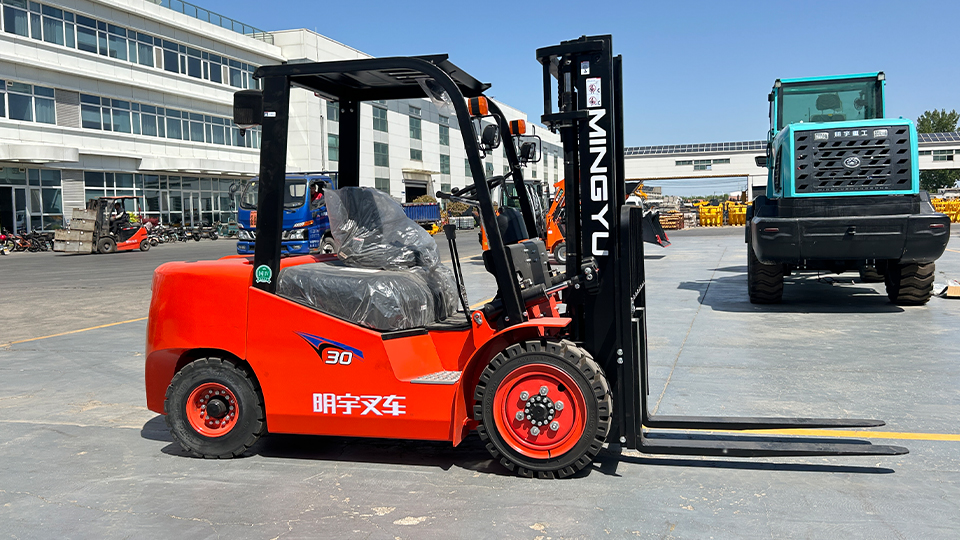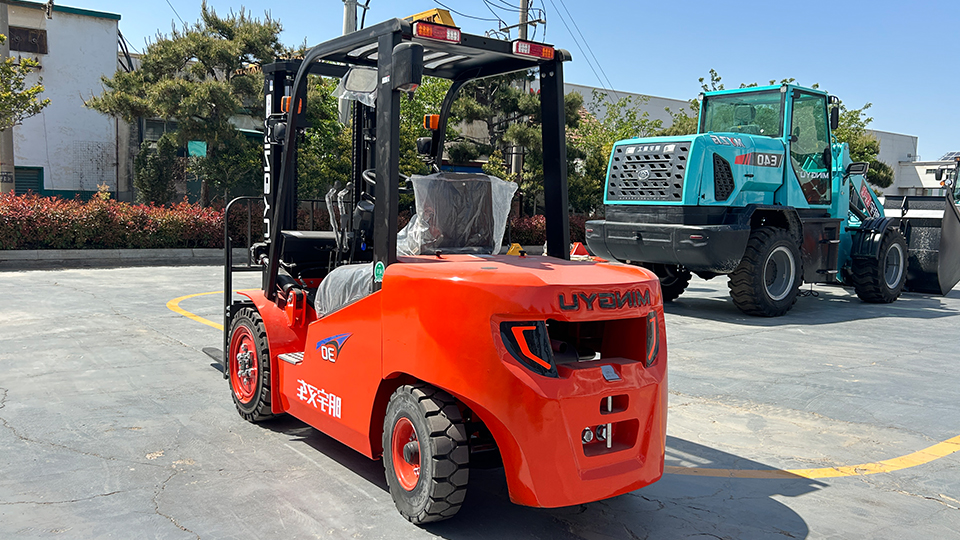
The Physics of Forklift Stability on an Incline
A forklift's stability is governed by its center of gravity (CG), which is the theoretical point where the entire weight of the machine and its load is concentrated. On level ground, a forklift's stability triangle, an imaginary three-point support system formed by the front wheels and the center of the rear axle, ensures equilibrium. However, when a forklift travels on a slope, the dynamics change dramatically.
Center of Gravity and the Stability Triangle
When a forklift ascends or descends a ramp, the CG shifts. The angle of the incline causes the weight to be redistributed, moving the CG closer to the tip of the stability triangle. This shift can be calculated using trigonometric functions, with the formula for the vertical shift (
where
is the distance of the CG from the rear axle and

is the angle of the incline.
A key concept to grasp is the "tip-over" point. This is the point where the line of action of the combined weight of the forklift and its load falls outside the stability triangle. When this happens, the forklift becomes unstable and will tip over. The risk of tipping is significantly higher on inclines due to the forward or backward shift of the CG.
Force Analysis: Gravity and Momentum
Two primary forces are at play when a forklift is on an incline: gravity and momentum.
Gravitational Force: Gravity always pulls the forklift's weight directly downward. On a slope, this force can be resolved into two components: one perpendicular to the ramp's surface (the normal force) and one parallel to the ramp's surface (the downhill force). The downhill force is what causes the forklift to want to roll down the slope. The magnitude of this force is given by:
is the total weight of the forklift and its load.
Momentum: As the forklift moves, it gains momentum. On an incline, this momentum adds to the forces acting on the machine. A sudden stop or change in direction can drastically alter the forces, potentially causing a loss of control or a tip-over.
Ascending an Incline: The "Load Trailing" Rule
When a forklift is traveling up a ramp without a load, the operator should travel with the forks pointing downhill. This might seem counterintuitive, but it's a critical safety measure. This configuration ensures that the forklift's weight is distributed toward the rear, where the counterweight is located, providing greater stability.
However, when ascending with a load, the operator must always travel with the load pointing uphill, or "forward." This is because the weight of the load shifts the combined center of gravity forward. By keeping the load facing uphill, the operator leverages the counterweight to balance the machine, preventing the CG from shifting too far forward and causing a backward tip-over. The combined CG is kept within the stability triangle, ensuring a safe ascent.
Technical Considerations for Ascent
Speed Control: Maintaining a slow, steady speed is paramount. Sudden acceleration can cause the load to shift, and sudden braking can cause a "wheelie" or a forward tip-over.
Fork Position: The forks should be tilted back slightly to secure the load against the carriage and prevent it from sliding off. The forks should be raised just enough to clear the ground, but not so high as to raise the CG unnecessarily.
Ramp Surface: The ramp's surface must be free of debris, oil, or water. Any of these can reduce traction, leading to wheel spin or a loss of control.
Descending an Incline: The "Load Trailing" Rule Revisited
The rules for descending an incline are the opposite of ascending. When descending without a load, the operator should travel with the forks pointing downhill. This ensures that the weight of the forklift is distributed towards the front, preventing a tip-over.
When descending with a load, the operator must always travel with the load pointing uphill, or "trailing." This is a non-negotiable safety rule. The load's weight, combined with the downward slope, significantly shifts the CG forward. By traveling with the load trailing, the operator uses the machine's counterweight to offset this forward shift, keeping the CG within the stability triangle. Attempting to descend with the load in front is a recipe for disaster, as the combined weight and momentum can easily cause the forklift to tip forward.
Technical Considerations for Descent
Braking: Use a combination of controlled braking and engine braking to maintain a slow, constant speed. Avoid sudden or heavy braking, which can cause the load to shift or the forklift to become unstable.
Steering: On an incline, steering can be more challenging. The operator must make small, precise adjustments to maintain a straight path. Sudden steering inputs can cause the forklift to sway and potentially tip.
Fork Position: Just as with ascending, the forks should be tilted back slightly to secure the load and raised just enough to clear the ground.

The Role of Counterweights and Load Capacity
A forklift's counterweight is a crucial component of its stability system. The counterweight, typically a heavy block of steel or cast iron, is located at the rear of the machine. Its purpose is to counteract the weight of the load, keeping the combined CG within the stability triangle.
When operating on an incline, the counterweight's effectiveness is altered. The angle of the ramp changes the line of action of the counterweight's force, reducing its ability to counteract the load's weight. This is why a forklift's rated capacity is lower on an incline than on a level surface. A forklift rated to lift 5,000 lbs on a level surface may only be able to safely lift 3,000 lbs on a 10-degree incline. Operators must be aware of these de-rating factors and consult the forklift's capacity plate and manufacturer's guidelines.
Calculating the De-rated Capacity
The de-rated capacity can be calculated using a simplified formula:
where $$C_{incline}$$is the capacity on the incline,
$$C_{level}$$is the capacity on a level surface, and$$θ$$
is the angle of the incline.
This formula demonstrates the direct relationship between the angle of the incline and the reduction in lifting capacity. Ignoring this factor can lead to overloading, which is a primary cause of tip-overs.
Practical Safety Protocols and Best Practices
Technical knowledge is only as good as its application. Here are some essential safety protocols and best practices for operating a forklift on an incline.
Pre-Operational Inspection: Before operating on any incline, perform a thorough pre-operational check. Inspect the brakes, tires, hydraulic system, and steering. A malfunction in any of these systems can be catastrophic on a ramp.
Operator Training: All operators must be formally trained and certified. This training should include a specific module on incline operation, covering the physics, safety rules, and practical exercises.
Signage and Markings: Ramps should be clearly marked with their maximum permissible angle and speed limits. These warnings serve as a constant reminder to operators of the inherent dangers.
No Turning on an Incline: A forklift should never be turned on an incline. Turning drastically shifts the CG and can easily cause the machine to tip over. If a change in direction is necessary, the operator should drive to the top or bottom of the ramp and make the turn on a level surface.
No Unnecessary Stopping: Avoid stopping on a ramp whenever possible. If a stop is necessary, the operator should engage the parking brake and ensure the load is stable before proceeding.
Maintain Clear Visibility: The operator must always have a clear line of sight. If the load obstructs the view, the operator should travel in reverse (with the load trailing) to ensure visibility.
Conclusion
Traveling on a ramp or incline with a forklift is a high-risk operation that demands a combination of technical knowledge, disciplined practice, and a respect for the laws of physics. Understanding the dynamic interplay between the forklift's center of gravity, the forces of gravity and momentum, and the critical role of the counterweight is essential for safe operation. By adhering to the "load trailing" rule, controlling speed, and following established safety protocols, operators can mitigate the risks and ensure that every ascent and descent is completed without incident. The safety of the operator, the cargo, and the facility rests on a foundation of sound technical understanding and unwavering commitment to best practices.
Name: selena
Mobile:+86-13176910558
Tel:+86-0535-2090977
Whatsapp:8613181602336
Email:vip@mingyuforklift.com
Add:Xiaqiu Town, Laizhou, Yantai City, Shandong Province, China